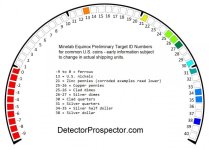TNTGross
Elite Member
SO I did the update on the Nox about 2 weeks ago and now I am getting some Odd VDI numbers on my finds.
For the most part, I hunt with the factory settings, Park 1, Recovery 3, F2, power 22-25.
In the past two weeks, I have found 3 Mercury dimes. Before the update, Mercs would ring up 26-27, but now I find them ringing up at 23-24. Also, pennies from the 60's-80's are ringing up between 22-23-24-25. Wheat Pennies 27-30.
Also, new clad dimes are ringing up 25-27 and silver Rosie dimes are hitting at 26-28.
What is bothering me is the Mercury dimes are ringing up like pennies, pennies ringing up like dimes and clad dimes ringing up like silver.
Hope you were able to follow this... Anyone else having this issue? Or is this normal? Basically, I want to know what the heck is going on.
For the most part, I hunt with the factory settings, Park 1, Recovery 3, F2, power 22-25.
In the past two weeks, I have found 3 Mercury dimes. Before the update, Mercs would ring up 26-27, but now I find them ringing up at 23-24. Also, pennies from the 60's-80's are ringing up between 22-23-24-25. Wheat Pennies 27-30.
Also, new clad dimes are ringing up 25-27 and silver Rosie dimes are hitting at 26-28.
What is bothering me is the Mercury dimes are ringing up like pennies, pennies ringing up like dimes and clad dimes ringing up like silver.
Hope you were able to follow this... Anyone else having this issue? Or is this normal? Basically, I want to know what the heck is going on.
Last edited:




